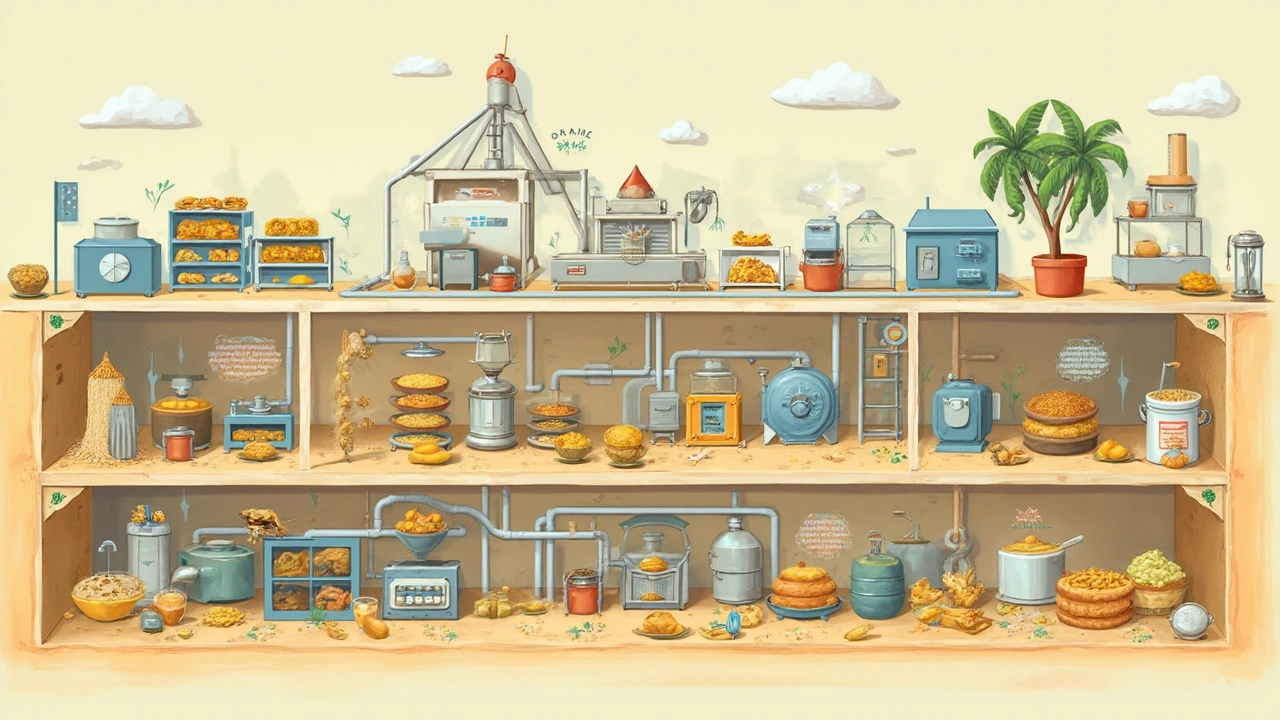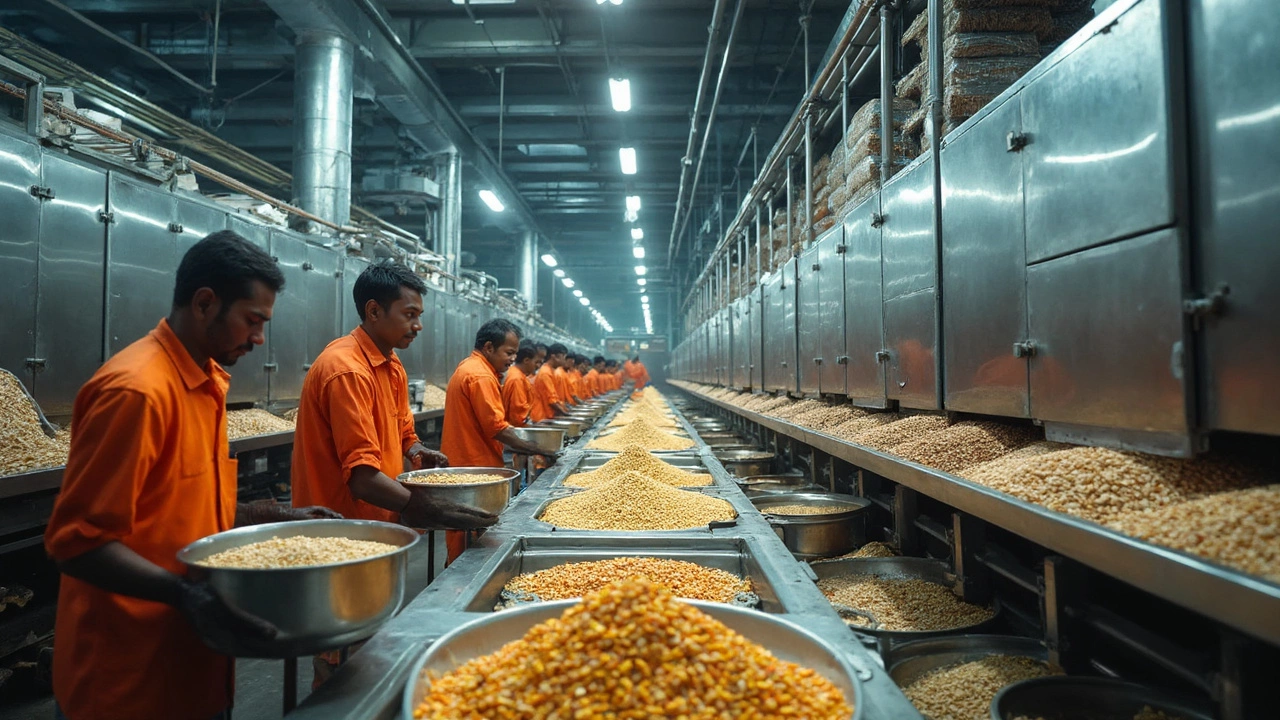Peek into any busy food factory, and you'll see rows of machines doing everything from washing veggies to sealing snacks. That magic starts with the food processing unit. This is a system—sometimes one machine, sometimes a group of them—built to turn raw food into something ready to eat or sell.
If you think about your favorite loaf of bread or those bagged salad greens you toss in your cart, they didn’t just happen overnight. First, they go through steps like cleaning, chopping, mixing, heating, cooling, sometimes even freezing—all handled by fiddly but reliable equipment. These units help companies keep food safe, cut waste, and get quality food out way faster than people could by hand.
And yes, even home cooks can use scaled-down versions. Air fryers, blenders, dehydrators—these are the food processing units most of us actually own. Once you understand how the big ones work, you start seeing the whole food world differently. Plus, you might spot ways to speed up your own meal prep or launch a food side hustle.
- What Exactly Is a Food Processing Unit?
- Types You’ll Find in the Food World
- How a Processing Unit Handles Food
- Why Food Processing Units Matter
- Starter Tips for Setting Up Your Own Unit
What Exactly Is a Food Processing Unit?
A food processing unit is basically any setup—could be a single machine or a whole production line—that takes raw ingredients and changes them into food that’s safe, tasty, and easy to store or transport. This could mean simple stuff like washing carrots or the more complicated jobs like making packaged snacks or dairy products. These units are found everywhere, from massive factories down to local bakeries and even food trucks.
The main goal is to make food last longer, look better, and stay safer. Most of the food you find in stores has passed through some kind of processing unit. Common jobs these machines do include:
- Sorting and cleaning (getting rid of dirt and damaged bits)
- Cutting, dicing, or grinding (breaking big stuff down into smaller, even pieces)
- Mixing and blending (for products like sauces and dough)
- Cooking or pasteurizing (to kill off nasty germs)
- Packing and sealing (for freshness and easy shipping)
Food processing units aren’t just for giant food brands. Small setups and even home appliances like food dehydrators or sausage stuffers are part of this club. They all help turn unfinished food into the stuff you really want to eat.
Here’s a quick look at how important this industry really is:
| Country | Annual Value of Food Processing Industry (USD) | % of Processed Food Sold in Stores |
|---|---|---|
| USA | Over $750 billion | More than 80% |
| India | About $300 billion | Close to 35% |
| Germany | Nearly $225 billion | About 70% |
The basic idea is simple. Without a food processing unit, modern food supply just wouldn’t work. Whether you’re running a bakery or just batch-cooking meals at home, you’re using the same principles—just on a smaller scale.
Types You’ll Find in the Food World
Walk into any food production space and you'll see a lineup of food processing units, each with its own specialty. Some handle washing, others slice, cook, mix, or package. All of them are built to save mess, time, and money—plus keep food consistent and safe.
Here's a quick breakdown of the most common types you’ll run into:
- Food processing washers: Designed to clean produce quickly, using water jets or gentle brushes. Some even kill bacteria with UV light.
- Slicers and dicers: These machines cut veggies, fruits, cheese, or meat fast and with exact size every time. Great for salads, frozen meals, and snacks.
- Mixers and blenders: Used everywhere, from big bakeries to sauce bottling lines. They whip, blend, and fold all sorts of ingredients for a consistent mix.
- Cookers and sterilizers: These use high heat (sometimes steam) to cook things evenly or kill off bacteria. Think about pasteurizing milk or making ready meals safe for months.
- Packaging machines: They do more than just wrap food. They vacuum-seal, shrink-wrap, or even fill jars automatically, making sure food stays fresh and protected on shelves.
Here's how different processing units stack up in some real factories in the U.S.:
| Type | Main Use | Avg. Speed (units/hr) |
|---|---|---|
| Washer | Vegetable Cleaning | Up to 10,000 lbs |
| Slicer/Dicer | Produce, Meats | 2,000 packs |
| Industrial Mixer | Dough, Sauces | 5,000 lbs |
| Sterilizer | Milk, Packaged Foods | 1,200 bottles |
| Packaging Unit | Sealing & wrapping | 6,000 packages |
Fun fact: Rex, my dog, only gets treats from brands that use top-notch processing units. It’s because these machines help keep out stuff like salmonella, which can make both pets and people sick.
Even small food businesses can get started with used or compact versions of these machines. There are entry-level slicers perfect for home use or countertop vacuum sealers that help you store leftovers and bulk buys way longer.

How a Processing Unit Handles Food
So, what exactly goes on inside these machines? Basically, a food processing unit takes raw stuff—think wheat, fruit, or meat—and puts it through a series of steps that make it safe and good to eat. The process depends on what you’re making, but most units follow a clear pattern.
- Cleaning: First up, everything gets washed. Dirt, debris, even tiny stones need to go. Some units use water sprays, others use air blowers or even vibration to shake off unwanted bits.
- Sorting and Grading: The next step often involves sorting food based on size or quality. Grains might pass through screens, while apples roll over belts that separate bruised ones from top pickers. This step keeps only the best stuff moving forward.
- Preparation: This is where peeling, chopping, slicing, or grinding comes in. For example, potato processing means peeling skins off before cutting them into fries. Most units have built-in blades, rollers, or grinders that do the job fast and consistently.
- Cooking or Heating: To make food safe and yummy, most processing units use heat—think boiling, steaming, or even baking. Pasteurizing milk or precooking frozen dinners both happen in this phase.
- Packaging: Once food is prepped and cooked, it goes into packages that keep it fresh. Some modern units even seal, label, and check weight without a human ever touching the product.
Each of these steps is designed to boost efficiency and food safety. For instance, getting everything cleaned right at the start reduces spoilage. Packaging in airtight bags keeps snacks crispy and safe from bacteria. That’s why so much of what we eat—cereal, cheese, frozen pizza—relies on these systems.
Here’s a tip if you’re thinking about adding a processing unit to your kitchen: focus on the steps you need to do again and again. If you’re always grinding nuts, a food processor pays off quickly. If you cook big batches, check out multi-use cookers that prep, steam, and keep things warm—no more juggling pots and pans.
Why Food Processing Units Matter
Without food processing units, modern grocery stores would look a lot emptier. You wouldn’t find your favorite cereal, cheese sticks, frozen foods, or even safe milk. Basically, these units take fresh crops or meat and turn them into something that can actually sit on shelves for days, weeks, or even months without spoiling.
The most obvious benefit? Food processing units keep food safe. By heating, cooling, or adding preservatives, they kill off bacteria—that's one of the main reasons food poisoning rates have dropped so much over the past 100 years. For example, pasteurization of milk, which happens inside specialized units, slashes the risk of diseases like listeria and salmonella.
They also help keep prices steady and bring down costs. When machines work faster and more consistently than people, companies can sell bagged salad, bread, and pasta for less. As a bonus, it cuts down on waste. Trimmings from processed foods can get reused or turned into animal feed, instead of just being thrown out. Don’t forget convenience. Families get more choice—from ready-made pizzas to jams—because processing units can handle huge volumes of different foods at the same time.
Check out how food processing units impact your daily life:
- Extend food shelf life so you toss less and save more at home.
- Make allergy-friendly foods possible by helping producers separate and control allergens.
- Let us enjoy seasonal foods—like strawberries—all year long by freezing or drying them at peak ripeness.
Here’s a quick snapshot showing what these units have done for food safety and convenience:
| Food | Pre-Processing Shelf Life | Post-Processing Shelf Life |
|---|---|---|
| Milk | 2 days (raw) | 2-3 weeks (pasteurized) |
| Bread | 2-3 days (fresh) | 7-10 days (packaged) |
| Frozen Vegetables | 1 week (fresh spinach) | 8-12 months (frozen) |
If you’re thinking about starting a food business or just love kitchen gadgets, knowing why these units matter is the first step to getting real results. They’re more than just machines—they’re the backbone that keeps pantries stocked and food waste low.

Starter Tips for Setting Up Your Own Unit
Ready to get serious about making your kitchen or garage the hub for processing foods? It’s not just about buying a shiny mixer; you need to set things up the right way. A good start can save you cash down the road and keep your food safe.
First things first, figure out what you’re going to process—veggies, fruits, meat, or baked treats. You’ll need specific tools for each job. Don’t try to do everything at once. Start small and focus on the foods you know best.
- Food processing equipment should be food-grade steel or BPA-free plastic. It’s not just safer but also a must if you plan to sell your products.
- Work out your workflow before you buy anything. Where will raw foods come in? Where will you chop, cook, and package? Keeping dirty and clean areas separate is a food safety game-changer.
- Ventilation matters. If you’re baking or cooking, steam and heat can turn your workspace into a sauna. Install a simple hood or make sure you’ve got windows you can crack open.
- Keep a close eye on temperature. For meat or dairy, you can’t play fast and loose—food safety guidelines say you need a fridge that holds 40°F (4°C) or below. Here’s a handy table with proper temps for some basic foods:
| Food Type | Recommended Temp |
|---|---|
| Fresh Produce | 32-41°F (0-5°C) |
| Meat | 32-40°F (0-4°C) |
| Dairy | 34-39°F (1-4°C) |
| Baked Goods | Room temperature (below 77°F/25°C) |
Sanitation is key. Wash surfaces with food-safe cleaners, and make hand-washing a habit—especially if you’ve got pets like my dog Rex hanging around looking for snacks. Cross-contamination can mess up your whole batch.
Think about packaging early. Foods like dried fruit or granola do best with airtight bags or containers. For jams or sauces, invest in jars with solid seals. Good packaging keeps flavor in and germs out.
If you’re dreaming bigger and want to pass an inspection or get certified, check out your local health department’s website. They’ll have details on permits, food handling courses, and what size operation needs which rules. Nobody likes paperwork, but skipping this step can shut you down before you even start.
Bottom line: set up your space with safety first, plan one food at a time, and don’t get cheap on the essentials. Start here and scaling up won’t be as tough when sales pick up.





